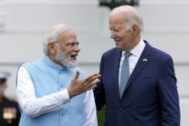Authors
Akhil Ramesh

Akhil Ramesh (IND) is Director of the India Program and Economic Statecraft Initiative at Pacific Forum. He holds an M.S. with a concentration in global macroeconomics from New York University in New York, a certificate in business and geopolitics from HEC Paris, France and a BBA from Amity University, India. Born and raised in India, Akhil started his career in the Philippines, and over the past seven years, he has lived and worked across three continents, wearing different hats with risk consulting firms, think tanks and governments. Most recently, he worked with the Australian Department of Foreign Affairs and Trade on geo-economic issues in southern India. Prior to that, based out of New York City, worked as a project coordinator and lead of the mapping project of China’s Belt and Road Initiative at the EastWest Institute. With research interests at the nexus of geoeconomics and security policy, he is currently working on a number of projects related to infrastructure development in Asia, supply chains, grand strategy in the Indo-Pacific. His analysis has been widely published across global and regional journals such as Nikkei Asia, South China Morning Post, The Hill, The Diplomat, National Interest, Economic Times and Hindustan Times.
Articles by Akhil Ramesh

This chapter was made possible through a grant from the Hindu American Foundation.
The Comparative Connections chapter on US-India relations covering the period September to December 2022 highlighted the challenge of getting past Cold-War era differences to fully capitalize on Indo-Pacific synergies. In the months between September and December of 2023, Cold War-era differences took center stage in the bilateral partnership. As a sliver of hope that the partnership would transform into a formal alliance emerged earlier in the year, these differences were spoilers. Differences in outlook brought to light the perennial challenges in the relationship and the need to get past the muscle memory of the Cold War for substantial engagement as defense and security allies. Despite these political and security differences, economic and technological cooperation largely expanded with increased cooperation in critical technologies and supply chain diversification initiatives. US industries broke new ground in expanding their footprint in India, and Indian conglomerates invested in the US, capitalizing on the Biden administration’s Inflation Reduction Act and other industrial policies.

US - India
May — August 2023From Non-Alignment to Realignment
This chapter was made possible through a grant from the Hindu American Foundation.
The US and India expanded cooperation across various domains in the second reporting period of 2023. The two moved to materialize projects and initiatives that were conceived in the first quarter, in wide-ranging domains with significant geopolitical and geoeconomic scope including defense cooperation, critical and emerging technologies, and infrastructure development. While New Delhi continued to straddle groupings such as BRICS, Shanghai Cooperation Organization, and the Quadrilateral Security Dialogue, the US-India partnership broke ground on more initiatives than any of India’s other bilateral relationships. Modi and Biden visited each other’s capitals and reaffirmed their commitment to a rules-based international order. The rousing reception Modi received in Washington and the continued US preeminence in most major trade and technology initiatives conceived by India highlighted the growing partnership between the two democracies. And the two leaders, while facing elections next year, seem willing to work together on common global priorities—sometimes at domestic political costs.

US - India
January — April 2023An Even Larger Role in Everything
This chapter was made possible through a grant from the Hindu American Foundation.
On May 24, 2022, President Joe Biden met Indian Prime Minister Narendra Modi on the sidelines of the Quad summit in Tokyo. According to the White House readout of the meeting, “The leaders reviewed the progress made in the US-India Comprehensive Global Strategic Partnership. They committed to deepen the Major Defense Partnership, encourage economic engagement that benefits both countries, and expand partnership on global health, pandemic preparedness, and critical and emerging technologies.” While such statements are often aspirational and lag in implementation, the first four months of 2023 show the renaissance in US-India ties to be real.

US - India
September — December 2022Friends with Benefits
This chapter was made possible through a grant from the Hindu American Foundation
2022 was a challenging year, not just for US-India relations, but for every India analyst trying to explain the Indian government’s position on the Russia-Ukraine conflict. Explaining to a non-IR audience India’s history of nonalignment during the Cold-War era and its current policy of multi-alignment was not a gratifying endeavor. While the last four months of 2022 did not have the friction and stress-tests as the first four of 2022 or the slow and steady expansion of relations that followed between May and September, they certainly had multiple surprising events that could make them the halcyon months of 2022. In mid-November, the US and Indian armies engaged in a military exercise at Auli, not far from the Line of Actual Control (LAC) separating Indian-held and Chinese-held territory. While the US and Indian armies have engaged in exercises prior to 2022, this proximity to the Indo-China border is a first. A month later, in another first, US Treasury Secretary Janet Yellen traveled to India to meet Indian Finance Minister Nirmala Sitharaman to expand the US-India “Indo-Pacific partnership.” Yellen characterized India as a “friendly shore” for supply chain diversification and as the indispensable partner for the US.

US - India
May — August 2022Relations at 75: Hawaii to the Himalayas
This chapter was made possible through a grant from the Hindu American Foundation
Like the saying, “after the storm comes the calm,” US-India relations witnessed four months of productive talks, cooperation, and collaboration. This contrasted with the previous trimester, mired as it was by Cold-War era differences brought about by the Russia-Ukraine conflict. There were thriving Indo-Pacific synergies and the decline of Cold War-era differences. The US and India continued and expanded cooperation on a wide array of regional and global issues, such as climate change, supply chains, and the Sri Lankan crisis. They solidified their defense partnership from Hawaii to the Himalayas through navy and military exercises. The US turned down pressure on India over Russian oil purchases and recalibrated the dialogue to address other pressing challenges. They did not avoid tough conversations, however. India reinforced its view of the US and other Western nations’ role in keeping the Indo-Pacific a safer and more open region.
While minor differences remain, the two democracies found common ground in addressing what they both consider to be the most pressing challenges: China’s belligerent actions and the existential threat of climate change. Their targeted actions to address the two issues became more overt and coordinated. Through the launch of initiatives such as the Indo-Pacific Economic Framework (IPEF), the Biden administration reentered the Asian economic architecture—though not through a trade agreement—bringing otherwise-hesitant economies, including India, into the fold.
Domestically, Biden and Modi were both preoccupied with amending historic injustices and preparing their societies and economies for 21st century challenges.

US - India
January — April 2022Cold-War Era Differences & Indo-Pacific Synergies
This chapter was made possible through a grant from the Hindu American Foundation.
2022 started with a surging omicron wave, followed by Russia’s invasion of Ukraine and a global food, energy, and supply shortage crisis that impacted a wide range of sectors. The United States and India worked collaboratively and individually to put out these fires over the first four months of 2022, becoming more aware of synergies to build on and differences to address. In the first four months of 2022 bilateral ties witnessed successes in their joint efforts. The Comprehensive Global Strategic Partnership between the US and India was in action through cooperation on vaccines and COVID-19-related supply chain resiliency initiatives. During the reporting period, India removed several agricultural trade barriers, the US unveiled its Indo-Pacific Strategy, foreign and defense ministers held their 2+2 meeting, and there were several phone conversations and in-person meetings between the two administrations discussing Ukraine, Afghanistan, and other Indo-Pacific issues. Historically, foreign affairs has not played a significant role in Indian state-level elections. However, domestic politics in India has a significant impact on foreign relations. On topics of trade, economic cooperation, infrastructure development, and even human rights, developments in state elections can profoundly impact US-India relations.